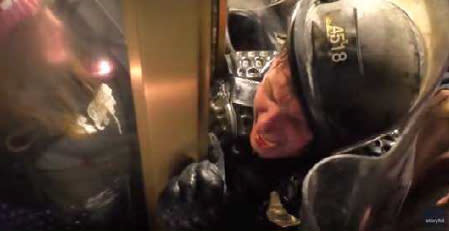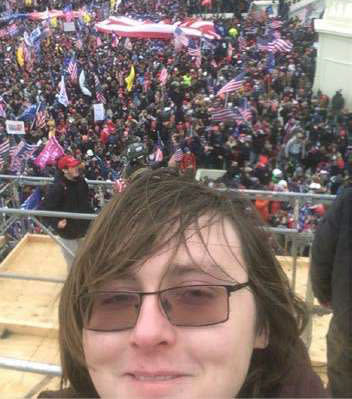D.C. Officer Daniel Hodges testifies against Capitol rioter who 'crushed' him with shield
WASHINGTON — A Washington, D.C., police officer who was crushed by a pro-Trump mob in a tunnel leading to the U.S. Capitol on Jan. 6, 2021, testified Tuesday against one of the rioters charged with assaulting him.
Metropolitan Police Officer Daniel Hodges, who has spoken publicly about being attacked at the Capitol, including before the Jan. 6 committee, appeared in court Tuesday for the trial of three Capitol defendants: Patrick McCaughey III, Tristan Stevens and David Mehaffie. The case is before U.S. District Judge Trevor McFadden, the only federal judge in Washington who has acquitted a Jan. 6 defendant.
McCaughey, the Justice Department alleged, "threw his body weight" against Hodges and pressed a stolen police shield against him. Citing a video that went viral after the Jan. 6 attack, federal prosecutors wrote in a trial brief that Hodges was "screaming out in pain, crushed between the shield held by defendant McCaughey and the door frame of the Capitol."
Hodges, who has said in media appearances that Donald Trump has a "cultlike" control over his supporters, told the court Tuesday that the attack "hurt a great deal" and that McCaughey's actions contributed to his injuries that day.
“It, combined with everything else that was going on, made it difficult to breathe," Hodges said. "Being crushed by the shield and the people behind it … leaving me defenseless, injured.”
“There is no good way to fight back against it," he testified. “You have to endure the pressure that it creates.”
Hodges testified that he had "never been in the United States Capitol building before” Jan. 6 and that his radio was stolen and he was separated from his platoon.
“I didn’t know where I was going. I didn’t know whether there was an avenue of egress for us to take. I was worried that we would be put up against the wall literally and figuratively," he testified.

After being crushed in the tunnel on the western side of the Capitol, he eventually headed away from the rioters and into the Capitol with the help of another officer who pulled him to safety.
“I knew maintaining that position and staying upright was untenable. If I was there much longer being assaulted in such a way, I knew it was very likely I wouldn’t be able to maintain my consciousness and become a liability to the other officers.”
Hodges said he felt relief but also a little embarrassment that he had to be pulled back so soon after having come under attack and having had another rioter rip his gas mask off, saying he had wanted to "return as soon as possible" to the battle.
The government showed images of Hodges' swollen hand and his bleeding bottom lip, and Hodges also testified that he had a contusion on the top of his head after the attack.
Assistant U.S. Attorney Kimberly Paschall, one of the federal prosecutors on the case, wielded a police shield during the trial, illustrating how, she said, McCaughey used it against Hodges and the police line.

McCaughey, Hodges testified, was among the Jan. 6 rioters who were trying to get police officers to stand down during the attack.
“He was trying to get us to surrender, to join them," Hodges said.
McCaughey's co-defendants Stevens and Mehaffie have also been charged in connection with the attack on police in the tunnel.
Mehaffie — whom online Jan. 6 investigators nicknamed "Tunnel Commander" — is charged with a felony count of assaulting, resisting, or impeding officers, as well as felony obstruction of an official proceeding and felony civil disorder. Federal prosecutors say he was "telling rioters when and where to push on the police line, how to enter and exit in the most efficient manner, and handing a shield into the rioters to set up a wall against the police."
Stevens, federal prosecutors say, hit Capitol Police Sgt. Aquilino Gonell with a police shield. He is charged with three counts of assaulting, resisting, or impeding certain officers, as well as obstruction of an official proceeding and civil disorder.
More than 850 people have been arrested in connection with the Jan. 6 attack, and the FBI has the names of hundreds more rioters who have not yet been arrested. The total number of people who unlawfully entered the Capitol on Jan. 6 is more than 2,500, and hundreds more are accused of assaulting law enforcement officers but not entering the Capitol.
More than 350 defendants have pleaded guilty, and more than a dozen have been found guilty at trial.
Proud Boy Joshua Pruitt was sentenced this week to 4½ years in federal prison, while Howard Richardson was sentenced to 3½ years after he used a Trump flag to assault an officer.
Two defendants have been sentenced to record terms of more than seven years in federal prison: Thomas Robertson, a former Virginia police officer, and Guy Reffitt, a Texas extremist whose own son tipped off the FBI about him before Jan. 6.
Federal prosecutors are seeking the longest sentence yet, 17½ years in federal prison, for ex-New York Police Officer Thomas Webster, who tackled a Washington police officer to the ground and tried to strike him with a flagpole on Jan. 6.
